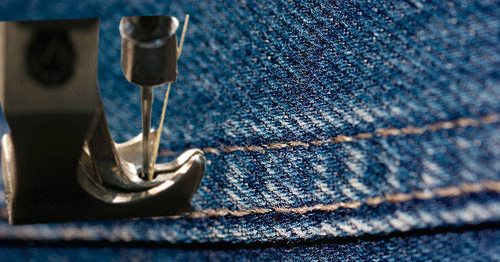
In this technical guide it can be understood how to sew extra heavy threads on denim to make the the products unique .Retail designers are always looking for a way to make their products unique and this definitely applies to sewing denim garments. From a thread perspective, this can include various options as listed below :
1) Using contrast color threads
- For all topstitching operations
- For different operations
- For different needles of the same operation
2) Using threads that will maintain their color regardless of the wash process.
- Using a 100% polyester thread dyed with disperse dyes.
3) Using threads that will wash-down depending on the severity of the finishing process.
- Using a cotton wrapped core thread.
- Using an true indigo dyed cotton wrapped core thread
4) Using a thread that looks different than regular stitching thread.
- Shiny thread
- Two-color thread like Design-A-Core®
5) Using different thread sizes that give a bolder stitch appearance.
In this guide, we will concentrate this option ie use bolder stitches on denim jeans .
Larger Thread Sizes That Give A Bolder Topstitch Appearance
Tex Size = Gram Weight Per 1000 meters of undyed yarn
Years ago the most common size of thread used for topstitching denim was a Tex 60 or 80 or possibly Tex 105 size threads. Recently many manufacturers have graduated to a Tex 120 size thread to give a slightly bolder stitch appearance. Today, many denim designers are looking at much heavier thread sizes including Tex 150, Tex 180, Tex 240 and even Tex 300.
This has created problems for many denim garment manufacturers because their normal denim sewing machines were not designed for these heavier threads.
WHAT DETERMINES THE THREAD SIZE THAT CAN BE SEWN ON A SEWING MACHINE?
On 301 lockstitch machines, the maximum needle thread size that can be 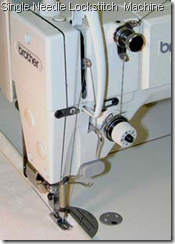
Sometimes an older hook will work better on larger threads because it has more play in the raceway allowing for more clearance for the thread.
The hook must also accommodate the use of larger than normal needles. In some cases, the retainer or gib of the hook is shaped differently to allow the 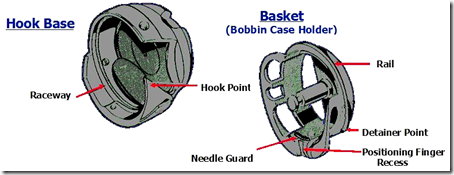
thread to of the hook with less resistance. Note that the hook must be properly lubricated.
Many sewing machine companies do make higher capacity Hooks that will allow larger threads to be sewn, but these are generally very expensive. 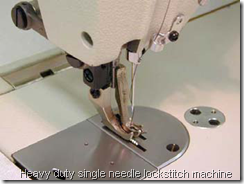
furniture and leather goods. Some manufacturers are purchasing these types of machines so they can sew extra large thread sizes up to Tex 500 or Tex 600 thread sizes!.
Heavy duty single needle lockstitch machine
Another option for sewing heavy threads on 301 lockstitch machines is to sew the heavy thread in the bobbin and using a regular size thread in the needle. This means that the seam is inverted when it is sewn. This is a common practice when setting front pockets or outlining the fly on a 5-pocket jean.
It is easier to use heavier thread sizes in the needle position of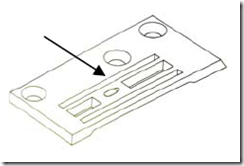
chainstitch machines, however, even these machine sometimes must be modified to allow the thread to be pulled up from under the needle plate with the least amount of resistance. This may include increasing the size of the needle hole in the needle plate.
RECOMMENDED NEEDLE SIZES FOR HEAVY THREADS
Most manufacturers who are sewing heavy denim are using a size 140 needle. When sewing heavier thread sizes, larger needle sizes must be used. Note: many times using a larger needle size will increase the occurrence of fabric damage and broken stitches due to needle-cutting.
| Thread Tex Size |
Minimum |
| T-105 – T-135 | 140 |
| T-150 | 150 |
| T-180 | 160 |
| T-240 | 200 |
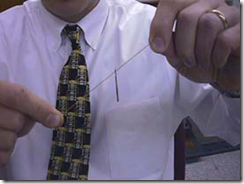
THREAD TENSIONS REQUIRED FOR HEAVY THREAD SIZES
Generally a heavier thread size will require more thread tension to properly set the stitch on denim fabric. The heavier the sewing thread being used, the more needle thread machine tension that will be required. Lockstitch machines will also require heavier takeup spring pressure. Also, all of the thread guides and eyelets may need to be used to help control the thread
during the sewing cycle. This will also help to keep “French†knots from forming in the thread path that can restrict the proper flow of thread to the needle.
Related Post : The A&E guide on ‘Denim Garment Stitching Recommendations’
Need any advice on denim sewing ? Contact Al Irvine from A & E at this email address.

